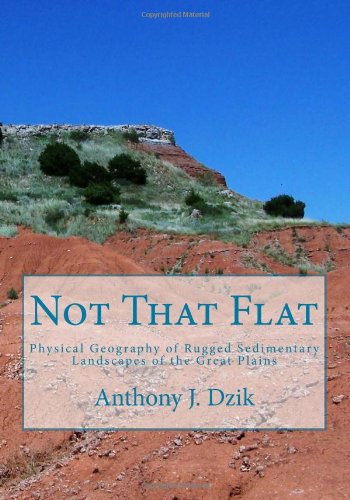 A recently published book about the Great Plains caught my attention a few weeks back. It’s called Not That Flat and it’s by Anthony J. Dzik who is a Professor of Geography at Shawnee State University in southern Ohio. The book deals with a variety of topographical features within the Great Plains in order to dispell the myth that the region is entirely flat.
A recently published book about the Great Plains caught my attention a few weeks back. It’s called Not That Flat and it’s by Anthony J. Dzik who is a Professor of Geography at Shawnee State University in southern Ohio. The book deals with a variety of topographical features within the Great Plains in order to dispell the myth that the region is entirely flat.
Anyone who has spent any amount of time in the Great Plains knows that its generally rolling character is puctuated with areas of greater relief – often in the form of badlands or buttes. Professor Dzik highlights some of the more obscure places in which to find significant topographical relief (many of them have been mentioned in this blog as well), such as the Killdeer Mountains of North Dakota, the Arikaree Breaks of Kansas and the Sweet Grass Hills of Montana. Those places are certainly little known enough, but what I found fascinating were the places I had never seen, and in some cases even heard of before, such as the Gloss Mountains of Oklahoma, the Red Hills of Kansas, and right in my back yard, the Paint Mines of Colorado. Many of these areas are not too far from where I live, and I’m excited to find some time to visit them.
Perhaps the best thing about the book is that its overall message is to redefine the Great Plains as a place of endless variety and intriguing landscapes. This parallels the goal of the Great Plains Trail which seeks to get people out to some of these areas and to view them as places for recreation, and as a refuge from the hectic pace of modern life. For decades, the mountains, forests, and even deserts of America have enjoyed this status as natural refuges. On the flip side, for decades, the Great Plains has wallowed in obscurity as the ugly step sister, but as Professor Dzik proves, it’s really “not that flat.” The time has come for the Great Plains and the grasslands to be added to the list of places where people can come to find adventure, or just to unwind.


7 Responses
I nominate Professor Dzik as the newest Board member for the Great Plains Trail.
Dzik has a great message here, so true.
Hey, just look at the cover photo on this page!
Absolutely . . . and given today’s news, it’s also good to know that the western portions of the Great Plains have few tornadoes. Tornadoes tend to be most numerous and most destructive east of the 100th meridian.
I just bought this book based on your mention of it here. I just went to the Paint Mines for the first time last week while driving from New York back to California. It is a fascinating place! For what it is worth, are you familiar with the Wichita Mountains? They are certainly one of the most dramatic places in the midst of the plains. Granite mountains, wilderness, beautiful scenery and unbeatable wildlife. I spent a lot of time there while I was in gradschool in Texas and it was my oasis of relief both from flatness and urban life. I now live in the mountains in northern California but still find myself longing to go back on a regular basis!
http://www.summitpost.org/charon-s-garden-wilderness/274583
http://www.summitpost.org/wichita-mountains/171222
Yes, the paint mines are interesting. Small, but interesting. I have yet to go the Wichita Mountains, but they’ve been on my list for a while. Great photos in that post! With their granite boulder outcroppings, they remind me of the smaller coastal mountains in San Diego County.
Actually, given the color of the granite and many of the shapes that the Wichita’s take, I have always thought it was a high plains version of the Lost Creek Wilderness in Colorado. That is one of my favorite corners of the Centennial State.
Despite living currently in Longmont, that’s an area I still haven’t checked out. Photos look awesome, and I can definitely see the resemblance.